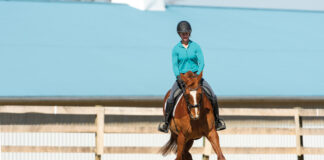One of the easiest ways you can improve your horse’s athleticism and fitness is to exercise him on various surfaces throughout the week. This not only fine-tunes his proprioception (the message system of his sensory and motor nerves) but leads to fuller recruitment of muscles and supporting soft tissue. Training in surfaces of different depths increases bone density and stimulates the layer of cartilage on the end of bones that cushions stride impact. From a performance standpoint, this offers a comfortable reward: the horse moves with more suspension and graceful gaits.

Many equestrians seek out consistent, well-groomed footing, but varying the surfaces your horse works on will help keep him sound and improve his fitness in the long run.
Muscles become stronger in proportion to the amount of stress put on them from work efforts. The same applies to bones. As a general rule, deeper footing stresses muscles, while harder surfaces stress bones. Having access to a variety of riding surfaces allows you to target both systems as needed. If you board at an arena with only access to an arena for exercise, aim to find ways to add time on different surfaces. This can be as simple as:
- A brisk walk up and down a firm driveway
- Riding around for 20 minutes on a grassy lawn
- Warming up in a round pen or paddock with different type of footing than your arena
Most horses that supplement their arena riding with weekly trail rides receive the stimulation of different surfaces as a natural outcome of these excursions. If you do not trail ride, though, it becomes especially critical that you get creative finding ways to log miles on a footing other than your arena.
Liked this article? Here are others you’ll enjoy:
Video: Let the Exercises Work for You
Video: Learn to Love the Canter
Video: Riding in Different Frames
Video: Feel Your Horse’s Muscle Development
JEC ARISTOTLE BALLOU is the author of 101 Dressage Exercises for Horse & Rider.







Another interesting and relevant article. Thanks, Horse Channel!
I wish I had access to different footing but I have to use what I have which is mainly road.